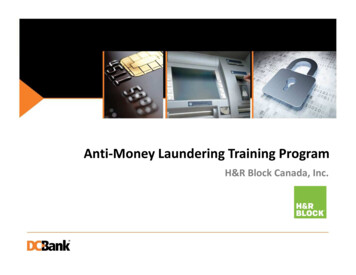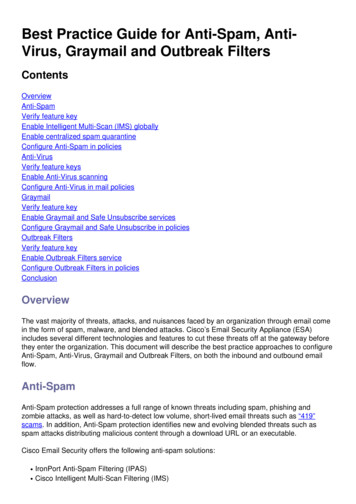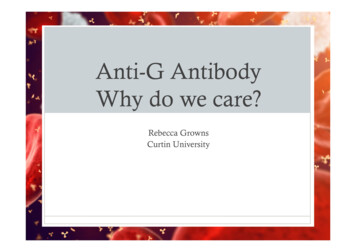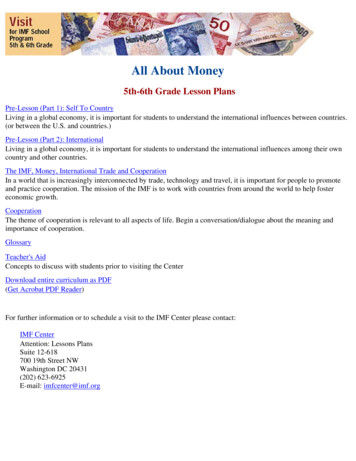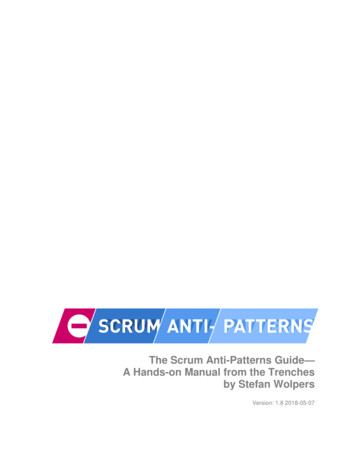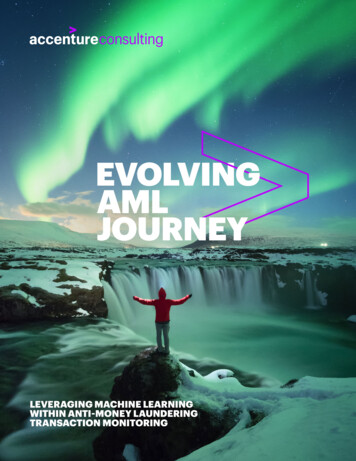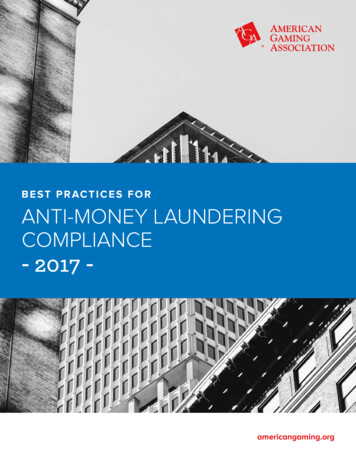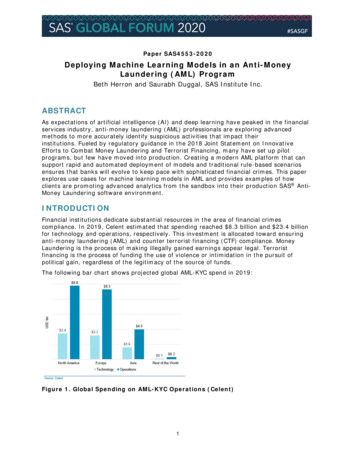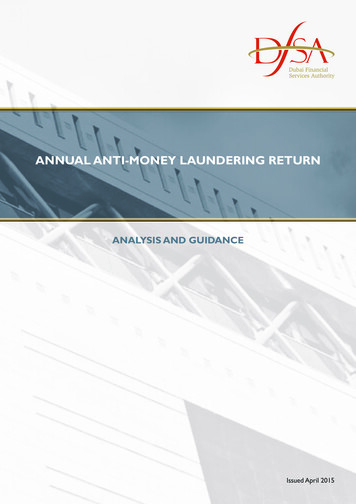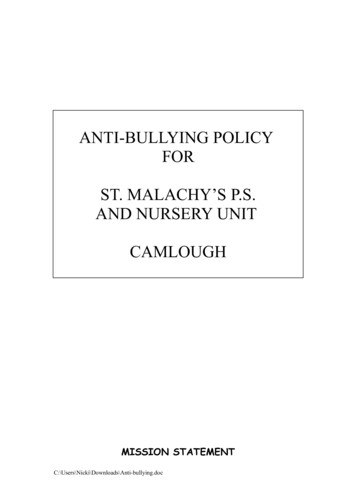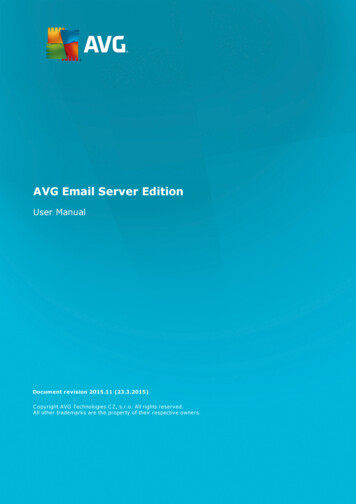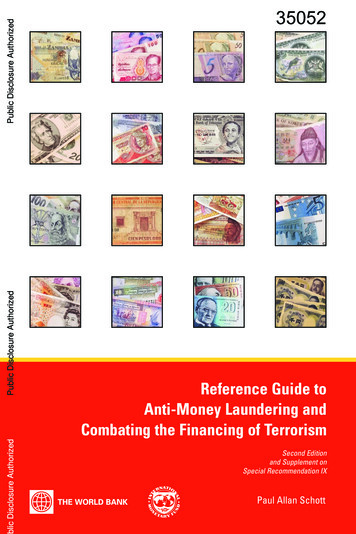
Transcription
Public Disclosure Authorizedblic Disclosure AuthorizedPublic Disclosure AuthorizedPublic Disclosure Authorized35052Reference Guide toAnti-Money Laundering andCombating the Financing of TerrorismSecond Editionand Supplement onSpecial Recommendation IXPaul Allan Schott
Reference Guide toAnti-Money Laundering andCombating the Financing of TerrorismSecond Editionand Supplement onSpecial Recommendation IX
Reference Guide toAnti-Money Laundering andCombating the Financing of TerrorismSecond Editionand Supplement onSpecial Recommendation IX
2006 The International Bank for Reconstruction and Development/The World Bank/The International Monetary Fund1818 H Street NWWashington DC 20433Telephone: 202-473-1000Internet: www.worldbank.orgE-mail: feedback@worldbank.orgAll rights reservedFirst printing of Second Edition and Supplement on Special Recommendation IX, January 20061 2 3 4 5 10 09 08 07 06This volume is a product of the staff of the International Bank for Reconstruction andDevelopment/The World Bank/The International Monetary Fund. The findings, interpretations,and conclusions expressed in this paper do not necessarily reflect the views of the World Bank, theInternational Monetary Fund, their Executive Directors, or the governments they represent.The World Bank and International Monetary Fund do not guarantee the accuracy of the dataincluded in this work. The boundaries, colors, denominations, and other information shown onany map in this work do not imply any judgment on the part of the World Bank or InternationalMonetary Fund concerning the legal status of any territory or the endorsement or acceptance ofsuch boundaries.Rights and PermissionsThe material in this publication is copyrighted. Copying and/or transmitting portions or all ofthis work without permission may be a violation of applicable law. The International Bank forReconstruction and Development/The World Bank/The International Monetary Fund encouragedissemination of their work and will normally grant permission to reproduce portions of the workpromptly.For permission to photocopy or reprint any part of this work, please send a request with completeinformation to the Copyright Clearance Center Inc., 222 Rosewood Drive, Danvers, MA 01923,USA; telephone: 978-750-8400; fax: 978-750-4470; Internet: www.copyright.com.All other queries on rights and licenses, including subsidiary rights, should be addressed to theOffice of the Publisher, The World Bank, 1818 H Street NW, Washington, DC 20433, USA; fax:202-522-2422; e-mail: pubrights@worldbank.org.ISBN: 0-8213-6513-4ISBN-13: 978-0-8213-6513-7eISBN: 0-8213-6514-2DOI: 10.1596/978-0-8213-6513-7Library of Congress Cataloging-in-Publication Data has been applied for.Cover and publication design: James E. Quigley, World Bank Institute.Cover photos: Comstock.www.amlcft.orgiv
ns and AcronymsIntroduction: How to Use this Reference GuidexvPart A: The Problem and the International ResponseChapter I: Money Laundering and Terrorist Financing:Definitions and ExplanationsA.B.C.D.E.F.G.What Is Money Laundering?What Is Terrorist Financing?The Link Between Money Laundering and Terrorist FinancingThe Magnitude of the ProblemThe ProcessesWhere Do Money Laundering and Terrorist Financing Occur?Methods and TypologiesI-1I-2I-4I-5I-6I-7I-9I-9Chapter II: Money Laundering Impacts DevelopmentII-1A. The Adverse Implications for Developing CountriesB. The Benefits of an Effective AML/CFT FrameworkII-2II-7Chapter III: International Standard SettersA.B.C.D.The United NationsThe Financial Action Task Force on Money LaunderingThe Basel Committee on Banking SupervisionInternational Association of Insurance SupervisorsvIII-1III-2III-7III-13III-16
Reference Guide to Anti-Money Laundering and Combating the Financing of TerrorismE. International Organization of Securities CommissionersF. The Egmont Group of Financial Intelligence UnitsChapter IV: Regional Bodies and Relevant GroupsA.B.C.D.FATF-Style Regional BodiesWolfsberg Group of BanksThe Commonwealth SecretariatOrganization of American States–CICADIII-18III-19IV-1IV-1IV-4IV-8IV-9Part B: The Elements of an Effective AML/CFT FrameworkChapter V: Legal System RequirementsA.B.C.D.E.F.G.H.Criminalization of Money LaunderingCriminalization of Terrorism and the Financing of TerrorismSeizure, Confiscation, and ForfeitureTypes of Covered Entities and PersonsSupervision and Regulation—Integrity StandardsLaws Consistent with Implementation of FATF RecommendationsCooperation Among Competent AuthoritiesInvestigationsChapter VI: Preventive MeasuresA.B.C.D.E.F.G.H.Customer Identification and Due DiligenceRecord Keeping RequirementsSuspicious Transaction ReportingCash Transaction ReportingBalancing Privacy Laws with Reporting and Disclosure RequirementsInternal Controls, Compliance and AuditRegulation and Supervision—Integrity StandardsLegal Entities and ArrangementsChapter VII: The Financial Intelligence UnitA.B.C.D.E.viDefinition of a Financial Intelligence UnitCore FunctionsTypes or Models of FIUsPossible Additional FunctionsOrganizing the VII-15VII-17
ContentsF. Privacy SafeguardsG. Information and FeedbackChapter VIII: International CooperationA. Prerequisites for Effective International CooperationB. General Principles of International Cooperation AgainstMoney LaunderingC. International Cooperation Between FIUsD. International Cooperation Between Financial Supervisory AuthoritiesE. International Cooperation Between Law Enforcement andJudicial AuthoritiesF. Considerations for Fiscal Matter OffensesChapter IX: Combating the Financing of TerrorismA. Ratification and Implementation of United Nations InstrumentsB. Criminalizing the Financing of Terrorism and AssociatedMoney LaunderingC. Freezing and Confiscating Terrorist AssetsD. Reporting Suspicious Transactions Related To TerrorismE. International CooperationF. Alternative Remittance SystemsG. Wire TransfersH. Non-Profit OrganizationsI. Cash CouriersJ. Self-Assessment Questionnaire on Terrorist -12IX-13IX-17Part C: The Role of the World Bank and International Monetary FundChapter X: World Bank and International Monetary FundInitiatives to Fight Money Laundering and Terrorist FinancingA.B.C.D.Awareness RaisingDevelopment of a Universal AML/CFT Assessment MethodologyBuilding Institutional CapacityResearch and AnalysisX-1X-3X-5X-6X-9vii
Reference Guide to Anti-Money Laundering and Combating the Financing of TerrorismAnnexesI.Websites for Key Organizations, Legal Instruments,and InitiativesII. Other Useful Websites and ResourcesIII. United Nations Anti-Terrorist Conventions Referred to in theInternational Convention for the Suppression of the Financingof TerrorismIV. The Financial Action Task Force Forty Recommendations onMoney Laundering and Interpretative NotesV. The Financial Action Task Force Special Recommendationson Terrorist FinancingVI. The Financial Action Task Force Interpretative Notesand Guidance Notes for the Special Recommendations onTerrorist Financing and the Self-Assessment QuestionnaireVII. Cross-Reference of The Forty Recommendations toReference GuideVIII. Cross-Reference of the Special Recommendations toReference GuideAnnex I-1Annex II-1Annex III-1Annex IV-1Annex V-1Annex VI-1Annex VII-1Annex VIII-1DiagramsThe Processes of Money Laundering and Financing of TerrorismviiiI-8
Forewordfforts to launder money and finance terrorism have been evolving rapidlyin recent years in response to heightened countermeasures. The international community has witnessed the use of increasingly sophisticated methods tomove illicit funds through financial systems across the globe and has acknowledged the need for improved multilateral cooperation to fight these criminalactivities.The World Bank and International Monetary Fund developed this secondedition of the Reference Guide to Anti-Money Laundering and Combatingthe Financing of Terrorism to help countries understand the new internationalstandards. The Reference Guide will hopefully serve as a single, comprehensivesource of practical information for countries to fight money laundering andterrorist financing. It discusses the problems caused by these crimes, the specific actions countries need to take to address them and the role internationalorganizations, such as the Bank and the Fund, play in the process.We offer this new version as a tool for countries to establish and improvetheir legal and institutional frameworks and their preventive measures according to the new international standards and best practices. This Second Editionof the Reference Guide and Supplement on Special Recommendation IX willalso be translated into Arabic, Chinese, French, Portuguese, Russian, andSpanish in order to better serve a broader audience.We intend to keep the Reference Guide under review as money laundering and terrorist financing trends and techniques, as well as the internationalresponse, evolve and to update it as necessary. We welcome your feedback andrecommendations on how this resource can be more useful.EMargery WaxmanR. Barry JohnstonJean-François ThonyProgram Director andSenior AdviserFinancial Market IntegrityWorld BankAssistant DirectorMonetary and FinancialSystems DepartmentInternational Monetary FundAssistant General CounselLegal DepartmentInternational Monetary Fundix
Acknowledgmentshis publication was written by Paul Allan Schott, consultant with theFinancial Market Integrity Unit of the Financial Sector of The WorldBank. The author is especially grateful to Margery Waxman, Director,Financial Market Integrity, World Bank, for her support, encouragement andpatience in producing the first and second edition of this Reference Guide.The author is grateful to his Bank and Fund colleagues for their willingness to read multiple drafts of the first edition and provide advice andinsights based on their work in the development and implementation of thejoint Bank/Fund program to combat money laundering and terrorist financing: John Abbott, Maud Julie Bokkerink, Pierre-Laurent Chatain, AlainDamais, Ross Delston, Gabriella Ferencz, Ted Greenberg, Raul HernandezCoss, Barry Johnston, Nadim Kyriakos-Saad, Samuel Maimbo, JohnMcDowell, Bess Michael, Michael Moore, Pramita Moni Sengupta, TakashiMiyahara, Thomas Rose, Heba Shams, Jean-François Thony, and CariVotava.Most importantly, the author wishes to thank Joseph Halligan for hiswork in updating the Reference Guide to reflect the revision of the FATF 40Recommendations and the methodology. Finally, the author could not haveproduced this comprehensive second edition without the work of Bank staffmembers who helped organize the material carefully, checked all referencesand made this publication a reality: Oriana Bolvaran, Nicolas de la Riva,Martín Joseffson, Amanda Larson, Annika Lindgren, Maria Orellano, JamesQuigley, Dafna Tapiero, Emiko Todoroki, and Tracy Tucker.Txi
Abbreviations and AcronymsAML anti-money launderingAPG Asia/Pacific Group on Money LaunderingBank World Bank GroupBasel Committee Basel Committee on Bank SupervisionBCCI Bank of Credit and Commerce InternationalCAS Country Assistance StrategyCFATF Caribbean Financial Action Task ForceCFT combating the financing of terrorismCTC United Nations Security Council CounterTerrorism CommitteeEgmont Group The Egmont Group of Financial Intelligence UnitsESAAMLG Eastern and Southern Africa Anti-MoneyLaundering GroupFATF Financial Action Task Force on MoneyLaundering, Group d’action Financière sur leblanchiment de capital (GAFI)FSRB FATF Style Regional BodiesFIU Financial Intelligence UnitThe Forty Recommendations The Forty Recommendations on MoneyLaundering issued by FATFFund International Monetary FundGAFI Group d’action Financière sue le blanchimentde capital (FATF)GAFISUD Financial Action Task Force on Money Launderingin South Americaxiii
Reference Guide to Anti-Money Laundering and Combating the Financing of TerrorismIAIS International Association of Insurance SupervisorsIFTs informal funds transfer systemsIMF International Monetary FundIOSCO International Organization of SecuritiesCommissionsKYC “know-your-customer”MONEYVAL Council of Europe the Select Committee ofExperts on the Evaluation of Anti-MoneyLaundering MeasuresMOU memorandum of understandingNCCT Non-Cooperative Countries and TerritoriesOAS Organization of American StatesOFC Offshore Financial CenterPalermo Convention United Nations Convention Against TransnationalOrganized Crime (2000)PC-R-EV Now known as MONEYVALROSC Report on Observance of Standards and CodesSpecial Recommendations Nine Special Recommendations on TerroristFinancing issued by FATFStrasbourg Convention Convention on Laundering, Search, Seizure andConfiscation of the Proceeds of Crime (1990)STR suspicious transaction reportsTA Technical AssistanceUN United NationsUNSCCTC United Nations Security Council CounterTerrorism CommitteeVienna Convention United Nations Convention Against IllicitTraffic in Narcotic Drugs and PsychotropicSubstances (1988)Wolfsberg Group Wolfsberg Group of Banksxiv
Introduction:How to Use this Reference Guidehis Second Edition of the Reference Guide is intended to serve as a single,comprehensive source of information for countries that wish to establishor improve their legal and institutional frameworks for anti-money laundering (AML) and combating the financing of terrorism (CFT). These issueshave become increasingly important in a global economy where funds can beeasily and immediately transferred from one financial institution to another,including transfers to institutions in different countries. The internationalcommunity is relying upon all countries to establish effective AML/CFTregimes that are capable of successfully preventing, detecting and prosecuting money laundering and terrorist financing in order to fight the devastatingeconomic and social consequences of these criminal activities.Part A of this Reference Guide describes the problem of money laundering and terrorist financing, their adverse consequences, and the benefits of aneffective regime. It also identifies the relevant international standard-settingorganizations and discusses their specific efforts and instruments that fightthese activities.Part B describes the various elements that are part of a comprehensivelegal and institutional AML and CFT framework for any country. Eachof these components has been established by the Financial Action Task onMoney Laundering (FATF) and the other international standard setters andeach element is essential to a comprehensive and effective regime. This partof the Reference Guide is a step-by-step approach to achieve compliance withinternational standards, although it does not dictate the specific methods oractions to be adopted. Rather, it raises the issues that must be addressed anddiscusses the options that a country has to resolve these issues.Part C describes the role of the World Bank and International MonetaryFund (IMF) in the global effort and the coordination of technical assistanceTxv
Reference Guide to Anti-Money Laundering and Combating the Financing of Terrorismavailable to countries in order to help them achieve compliance with international standards.Each chapter is a self-contained discussion of the topics covered in thatchapter (although references are made to related discussions in other chapters) with detailed references to background and original source materials.Annexes I, II and III provide complete citations to reference materials thatare used in the Reference Guide or that are otherwise useful to a country indealing with the many difficult issues associated with AML and CFT. Forconvenience, Annexes IV and V restate the international standards set byFATF, The Forty Recommendations on Money Laundering (revised in 2003),Glossary and Interpretative Notes and the nine Special Recommendations onTerrorist Financing, respectively. Annex VI is FATF’s Interpretative Notes andGuidance Notes for the Special Recommendations on Terrorist Financing andSelf-Assessment Questionnaire for countries on terrorist financing. Finally,Annexes VII and VIII are cross references for the FATF recommendations todiscussions in the Reference Guide.As a country reviews its AML and CFT legal and institutional frameworks, it may wish to use the Comprehensive Methodology on AML/CFTreferred to in Chapter X as its own checklist and self-assessment mechanism.This is the same Methodology used by FATF, the FATF-style regional bodies,the Bank and IMF in making assessments of either their own members or ofother countries.xvi
Chapter IMoney Laundering and TerroristFinancing: Definitions and ExplanationsA. What Is Money Laundering?E. The Processes1. Placements2. Layering3. IntegrationB. What is Terrorist Financing?C. The Link Between Money Launderingand Terrorist FinancingF. Where Do Money Laundering and TerroristFinancing Occur?D. The Magnitude of the ProblemG. Methods and Typologiesor most countries, money laundering and terrorist financing raise significant issues with regard to prevention, detection and prosecution.Sophisticated techniques used to launder money and finance terrorism addto the complexity of these issues. Such sophisticated techniques may involvedifferent types of financial institutions; multiple financial transactions; theuse of intermediaries, such as financial advisers, accountants, shell corporations and other service providers; transfers to, through, and from differentcountries; and the use of different financial instruments and other kinds ofvalue-storing assets. Money laundering is, however, a fundamentally simpleconcept. It is the process by which proceeds from a criminal activity are disguised to conceal their illicit origins. Basically, money laundering involves theproceeds of criminally derived property rather than the property itself.The financing of terrorism is also a fundamentally simple concept. Itis the financial support, in any form, of terrorism or of those who encourage, plan, or engage in terrorism. Less simple, however, is defining terrorismFI-1
Reference Guide to Anti-Money Laundering and Combating the Financing of Terrorismitself, because the term may have significant political, religious, and nationalimplications from country to country. Money laundering and terrorist financing often display similar transactional features, mostly having to do withconcealment.Money launderers send illicit funds through legal channels in order toconceal their criminal origins, while those who finance terrorism transferfunds that may be legal or illicit in origin in such a way as to conceal theirsource and ultimate use, which is the support of terrorism. But the result isthe same—reward. When money is laundered, criminals profit from theiractions; they are rewarded by concealing the criminal act that generates theillicit proceeds and by disguising the origins of what appears to be legitimateproceeds. Similarly, those who finance terrorism are rewarded by concealingthe origins of their funding and disguising the financial support to carry outtheir terrorist stratagems and attacks.A. What Is Money Laundering?Money laundering can be defined in a number of ways. Most countries subscribe to the definition adopted by the United Nations Convention AgainstIllicit Traffic in Narcotic Drugs and Psychotropic Substances (1988) (ViennaConvention)1 and the United Nations Convention Against TransnationalOrganized Crime (2000) (Palermo Convention):2 The conversion or transfer of property, knowing that such propertyis derived from any [drug trafficking] offense or offenses or from anact of participation in such offense or offenses, for the purpose ofconcealing or disguising the illicit origin of the property or of assistingany person who is involved in the commission of such an offense oroffenses to evade the legal consequences of his actions; The concealment or disguise of the true nature, source, location, disposition, movement, rights with respect to, or ownership of property,knowing that such property is derived from an offense or offenses orfrom an act of participation in such an offense or offenses, /www.undcp.org/adhoc/palermo/convmain.html.
Money Laundering and Terrorist Financing: Definitions and Explanations The acquisition, possession or use of property, knowing at the time ofreceipt that such property was derived from an offense or offenses orfrom an act of participation in such offense or offenses.3The Financial Action Task Force on Money Laundering (FATF), whichis recognized as the international standard setter for anti-money laundering (AML) efforts,4 defines the term “money laundering” succinctly as “theprocessing of criminal proceeds to disguise their illegal origin” in order to“legitimize” the ill-gotten gains of crime.5A money laundering predicate offense is the underlying criminal activity that generated proceeds, which when laundered, results in the offenseof money laundering. By its terms, the Vienna Convention limits predicateoffenses to drug trafficking offenses. As a consequence, crimes unrelated todrug trafficking, such as, fraud, kidnapping and theft, for example, do notconstitute money laundering offenses under the Vienna Convention. Overthe years, however, the international community has developed the view thatpredicate offenses for money laundering should go well beyond drug trafficking. Thus, FATF and other international instruments have expanded theVienna Convention’s definition of predicate offenses to include other seriouscrimes.6 For example, the Palermo Convention requires all participant countries to apply that convention’s money laundering offenses to “the widestrange of predicate offenses.”7In its 40 recommendations for fighting money laundering (The FortyRecommendations), FATF specifically incorporates the technical andlegal definitions of money laundering set out in the Vienna and PalermoConventions and lists 20 designated categories of offences that must beincluded as predicate offences for money laundering.83.4.5.6.7.8.See Vienna Convention, articles 3(b) and (c)(i); and Palermo Convention, article 6(i).See Chapter III, B., FATF.FATF, What is money laundering?, Basic Facts About Money Laundering, http://www.fatfgafi.org/MLaundering en.htm.See discussion at Chapter V, A.,2., The Scope of the Predicate Offenses.The Palermo Convention, Article 2 (2), he Forty Recommendations, Rec. 1; http://www.fatf-gafi.org/pdf/40Recs-2003 en.pdf. Seealso Chapter V, Criminalization of Money Laundering, of this Reference Guide.I-3
Reference Guide to Anti-Money Laundering and Combating the Financing of TerrorismB. What Is Terrorist Financing?The United Nations (UN) has made numerous efforts, largely in the form ofinternational treaties, to fight terrorism and the mechanisms used to financeit. Even before the September 11th attack on the United States, the UN hadin place the International Convention for the Suppression of the Financing ofTerrorism (1999), which provides:1. Any person commits an offense within the meaning of this Conventionif that person by any means, directly or indirectly, unlawfully and willingly, provides or collects funds with the intention that they should beused or in the knowledge that they are to be used, in full or in part, inorder to carry out:a. An act which constitutes an offence within the scope of and asdefined in one of the treaties listed in the annex; orb. Any other act intended to cause death or serious bodily injury toa civilian, or to any other person not taking any active part in thehostilities in a situation of armed conflict, when the purpose ofsuch act, by its nature or context, is to intimidate a population, orto compel a government or an international organization to do orto abstain from doing an act.2. .3. For an act to constitute an offense set forth in paragraph 1, it shall notbe necessary that the funds were actually used to carry out an offensereferred to in paragraph 1, subparagraph (a) or (b).9The difficult issue for some countries is defining terrorism. Not all ofthe countries that have adopted the convention agree on specifically whatactions constitute terrorism. The meaning of terrorism is not universallyaccepted due to significant political, religious and national implications thatdiffer from country to country.9.I-4International Convention for the Suppression of the Financing of Terrorism (1999), Article 2,http://www.un.org/law/cod/finterr.htm. The conventions referred to in the annex in sub-paragraph 1(a) are listed in Annex III of this Reference Guide.
Money Laundering and Terrorist Financing: Definitions and ExplanationsFATF, which is also recognized as the international standard setter forefforts to combat the financing of terrorism (CFT),10 does not specificallydefine the term financing of terrorism in its nine Special Recommendationson Terrorist Financing (Special Recommendations)11 developed followingthe events of September 11, 2001. Nonetheless, FATF urges countries toratify and implement the 1999 United Nations International Conventionfor Suppression of the Financing of Terrorism.12 Thus, the above definitionis the one most countries have adopted for purposes of defining terroristfinancing.C. The Link Between Money Laundering and Terrorist FinancingThe techniques used to launder money are essentially the same as those usedto conceal the sources of, and uses for, terrorist financing. Funds used to support terrorism may originate from legitimate sources, criminal activities, orboth. Nonetheless, disguising the source of terrorist financing, regardless ofwhether the source is of legitimate or illicit origin, is important. If the sourcecan be concealed, it remains available for future terrorist financing activities.Similarly, it is important for terrorists to conceal the use of the funds so thatthe financing activity goes undetected.For these reasons, FATF has recommended that each country criminalizethe financing of terrorism, terrorist acts and terrorist organizations,13 anddesignate such offenses as money laundering predicate offenses.14 Finally,FATF has stated that the nine Special Recommendations combined with TheForty Recommendations on money laundering15 constitute the basic framework for preventing, detecting and suppressing both money laundering andterrorist financing.Efforts to combat the financing of terrorism also require countries toconsider expanding the scope of their AML framework to include non-profitorganizations, particularly charities, to make sure such organizations are not10.11.12.13.14.15.See Chapter III, B., FATF.The Special Recommendations are reprinted in Annex V of this Reference Guide.Id., at Spec. Rec. I.Id., at Spec. Rec. II.Id.Id., at introductory paragraph.I-5
Reference Guide to Anti-Money Laundering and Combating the Financing of Terrorismused, directly or indirectly, to finance or support terrorism.16 CFT effortsalso require examination of alternative money transmission or remittancesystems, such as hawalas. This effort includes consideration of what measures should be taken to preclude the use of such entities by money launderers and terrorists.17As noted above, a significant difference between money laundering andterrorist financing is that the funds involved may originate from legitimatesources as well as criminal activities. Such legitimate sources may includedonations or gifts of cash or other assets to organizations, such as foundations or charities that, in turn, are utilized to support terrorist activities orterrorist organizations. Consequently, this difference requires special laws todeal with terrorist financing. However, to the extent that funds for financingterrorism are derived from illegal sources, such funds may already be covered by a country’s AML framework, depending upon the scope of predicateoffenses for money laundering.D. The Magnitude of the ProblemBy their very nature, money laundering and terrorist financing are gearedtowards secrecy and do not lend themselves to statistical analysis. Launderersdo not document the extent of their operations or publicize the amount oftheir profits, nor do those who finance terrorism. Moreover, because theseactivities take place on a global basis, estimates are even more difficult toproduce. Launderers use various countries to conceal their ill-gotten proceeds, taking advantage of differences among countries with regard to AMLregimes, enforcement efforts and international cooperation. Thus, reliableestimates on the size of the money laundering and terrorist financing problems on a global basis are not available.With regard to money laundering only, the International Monetary Fundhas estimated that the aggregate amount of funds laundered in the worldcould range between two and five per cent of the world’s gross domesticproduct. Using 1996 statistics, these percentages would approximate between16. Special Recommendations, Spec. Rec. VIII.17. Special Recommendations, Spec. Rec. VI.I-6
Money Laundering and Terrorist Financing: Definitions and ExplanationsUS 590 billion and US 1.5 trillion.18 Thus, by any estimate, the size of theproblem is very substantial and merits the complete attention of every country.E. The ProcessesThe initial concern over money laundering began with its early connectionto illegal trafficking in narcotic drugs. The objective of drug traffickerswas to convert typically small denominations of currency into legal bankaccounts, financial instruments, or other assets. Today, ill-gotten gains areproduced by a vast range of criminal activities—among them political corruption, illegal sales of weapons, and illicit trafficking in and exploitationof human b
edition of the Reference Guide to Anti-Money Laundering and Combating the Financing of Terrorism to help countries understand the new international standards. The Reference Guide will hopefully serve as a single, comprehensive source of practical information for countries to fight money laundering and terrorist financing.
